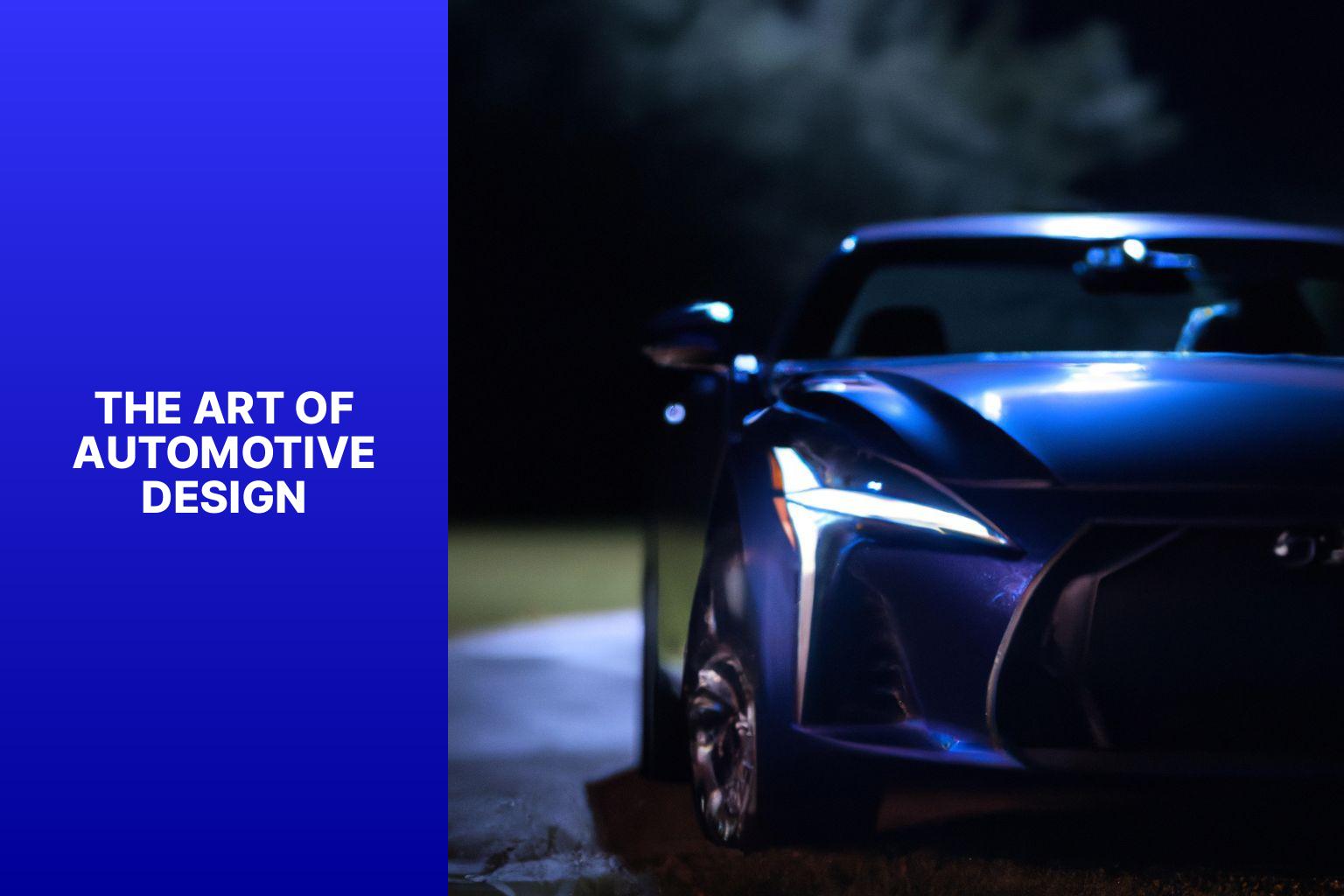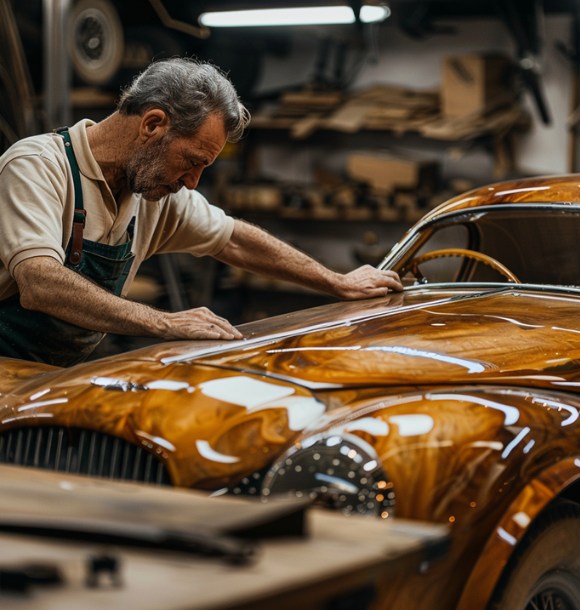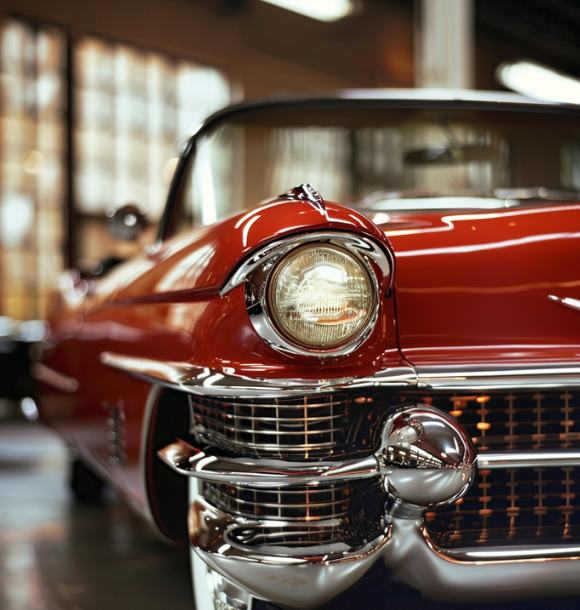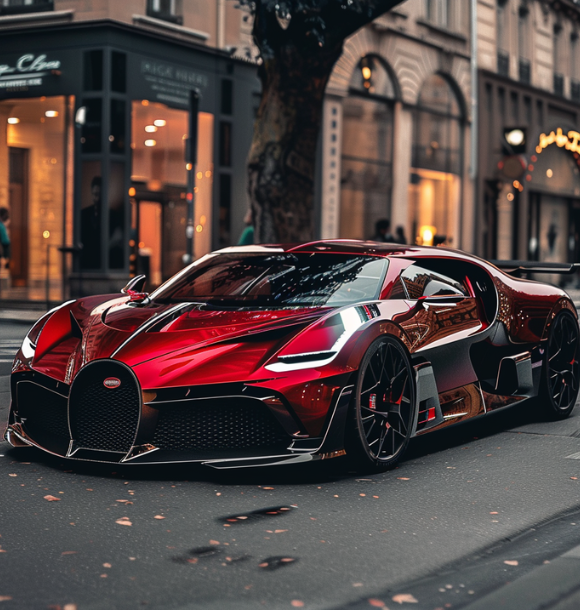Craftsmanship and Cars: Appreciating the Art Behind Men’s Favorite Vehicles
Craftsmanship and Cars: Appreciating the Art Behind Men’s Favorite Vehicles
The art of automotive design goes beyond the practicality and functionality of cars. It encompasses the aesthetics, attention to detail, and the skillful craftsmanship that brings these vehicles to life. In this article, we will explore the art behind men’s favorite vehicles, delving into the intricate world of car design and manufacturing.+

Understanding the Aesthetics of Car Design
Car design is a harmonious blend of form and function. It involves carefully considering every curve, line, and detail to create a visually appealing and aerodynamic vehicle. From the sleek contours of a sports car to the elegant curves of a luxury sedan, automotive designers are artists who sculpt metal and shape dreams.
Emphasizing the Role of Handcrafted Details
While modern automation has evolved car manufacturing, handcrafted details still hold a significant place in the process. Skilled artisans meticulously create intricate elements such as hand-stitched leather upholstery, hand-carved wooden trims, and hand-painted pinstripes. These details add a touch of exclusivity, luxury, and personality to each car.
Appreciating the Skill and Precision in Car Manufacturing
Car manufacturing is an art that requires skill, precision, and attention to detail. The engine building process, for instance, involves carefully assembled components, precise machining, and expert tuning to achieve optimal performance. Bodywork and paint technicians meticulously prepare and finish the car’s exterior, ensuring flawless finishes and stunning paintwork. Interior designers create spaces that seamlessly blend comfort, functionality, and style.
Cars as a Reflection of the Craftsman’s Vision
Craftsmanship plays a crucial role in shaping the performance and characteristics of a vehicle. The meticulous engineering, choice of materials, and fine-tuning of every component contribute to the overall driving experience. car culture celebrates personalization and customization, allowing individuals to express their unique tastes and preferences through their vehicles.
Recognizing Iconic Cars as Masterpieces
Some cars transcend their status as mere means of transportation and become true works of art. Classic cars evoke nostalgia and showcase timeless design elements that continue to inspire today. On the other hand, supercars combine exceptional performance with striking aesthetics, pushing the boundaries of automotive engineering and design.
As we explore the art behind men’s favorite vehicles, we will delve deeper into each aspect of craftsmanship and cars. From the aesthetics of car design and the role of handcrafted details to the skill and precision in car manufacturing, we will uncover the artistry that makes cars more than just machines. That is why men, and enthusiasts alike, appreciate their favorite vehicles as art forms that ignite passion, admiration, and a sense of wonder.
Key Takeaways:
- Craftsmanship and Cars celebrate the fusion of artistry and functionality: The art of automotive design blends aesthetics and engineering principles, making cars a unique art form that reflects the vision of skilled craftsmen.
- Handcrafted details elevate car design: Attention to detail and handcrafted elements in car manufacturing enhance the overall aesthetics and quality, showcasing the skill and precision of the craftsmen involved.
- Iconic cars embody masterpieces: Classic cars and supercars represent timeless design and exceptional performance, showcasing the exceptional craftsmanship and artistry behind these men’s favorite vehicles.
The Art of Automotive Design

Photo Credits: Www.Moderngentlemanmagazine.Com by Ethan Anderson
In the realm of automotive marvels, the artistry of car design reigns supreme. Buckle up as we explore the captivating world of automotive design, where every curve and contour is a stroke of artistic genius. Get ready to delve into the sub-sections that uncover the nuances of car aesthetics and the significance of handcrafted details in creating these man-made wonders. So, grab the wheel and let’s embark on an artistic journey through the captivating realm of automotive design!
Understanding the Aesthetics of Car Design
Understanding the aesthetics of car design is crucial in appreciating the artistry behind these vehicles. Car designers carefully consider the proportions, lines and curves, grille and headlights, wheel design, and color and finishes when creating a visually appealing car. Every detail, from the balance of the proportions to the choice of colors, contributes to the overall beauty and uniqueness of a car. So, next time you admire a car, take a moment to consider the aesthetic choices that make it a work of art.
Emphasizing the Role of Handcrafted Details
Handcrafted details enhance the beauty and uniqueness of cars. Skilled artisans meticulously craft each curve and contour of the car’s exterior, creating visually appealing aesthetics. The hand-rolled body panels and hand-stitched leather accents elevate the design, adding a sense of luxury and exclusivity.
Handcrafted details can also be found in the car’s interior. Meticulously stitched leather seats and hand-carved wooden trim provide a luxurious and comfortable experience for the driver and passengers. These details enhance the interior’s visual appeal and contribute to the overall ambiance and craftsmanship.
The role of handcrafted details goes beyond aesthetics. They demonstrate the skill, dedication, and attention to detail of the craftsmen. These details reflect the craftsmen’s vision and their commitment to creating an exceptional driving experience.
Appreciating the Skill and Precision in Car Manufacturing
Craftsmanship and Cars: Appreciating the Art Behind Men’s Favorite Vehicles invites us to delve into the world of car manufacturing, where skill and precision are paramount. In this section, we will explore three key aspects that make automotive craftsmanship truly remarkable: the artistry behind engine building, the meticulousness of bodywork and paint, and the attention to detail in interior design and upholstery. Get ready to be mesmerized by the craft and beauty that goes into creating the cars we love.
The Art of Engine Building
The art of engine building is a delicate process that requires meticulous craftsmanship and precision. Engines serve as the heart of a car, necessitating technical expertise and paying attention to even the smallest details.
Engine building begins with the design phase, where engineers meticulously plan and design every element of the engine. During this process, they take into account power output, efficiency, and reliability, employing advanced technologies to optimize performance.
A vital aspect of engine building is component selection, where skilled craftsmen carefully choose high-quality materials and parts that meet specific specifications. Factors such as durability, performance, and compatibility are thoroughly considered during this process.
The assembly stage is carried out by skilled technicians who expertly fit and align the engine’s components. They pay close attention to details, torquing bolts, connecting wiring, and installing sensors following precise instructions.
Following assembly, engines undergo rigorous testing and tuning. Craftsmen utilize diagnostic tools to check for any issues or performance discrepancies. Through this process, they fine-tune the engine to achieve optimal power, fuel efficiency, and overall performance.
The final stage of engine building involves strict quality control measures. Technicians thoroughly inspect the engine for defects and conduct tests to ensure that performance and reliability meet exceptionally high standards.
The Perfection of Bodywork and Paint
The perfection of bodywork and paint in car manufacturing exemplifies the skill and precision necessary to create flawless exteriors. Each step in the process, from shaping the panels to applying the final coat, contributes to achieving an impeccable finish.
To begin, craftsmen meticulously shape the metal or composite panels to obtain the desired form, ensuring flawless curves and lines. Their focus is on attaining precision and uniformity for aesthetic purposes.
Once the bodywork is flawlessly crafted, attention then shifts to the paint application. The surface is primed to establish a smooth base, and then multiple layers of paint are meticulously added to ensure consistent color and a flawless finish. Special techniques, including wet sanding and buffing, are employed to eliminate any imperfections and enhance the overall smoothness.
The perfection of bodywork and paint not only enhances the visual appeal of the car but also ensures improved durability. Through meticulous preparation and application, proper adhesion is achieved, providing protection against UV rays and corrosion.
Attention to Interior Design and Upholstery
Attention to Interior Design and Upholstery is crucial in creating luxurious and functional car interiors. Craftsmanship plays a significant role in achieving the desired aesthetic and comfort levels.
1. Material selection: Craftsmen carefully choose high-quality materials for car interiors. They select premium fabrics, leathers, and trims that enhance the visual appeal and provide a luxurious feel.
2. Detailed craftsmanship: Attention to detail is essential in interior design and upholstery. Craftsmen meticulously stitch and sew upholstery materials, ensuring precise lines and smooth finishes.
3. Ergonomics and functionality: Craftsmanship in car interiors goes beyond visual aesthetics. Craftsmen focus on creating ergonomic designs that prioritize comfort and functionality. They consider factors like seating positions, control placement, and storage options to enhance the user experience.
4. Customization options: Craftsmen offer various customization options to cater to different preferences. They allow for selecting upholstery color and texture, as well as incorporating personalized features. This craftsmanship enables the creation of unique and personalized car interiors.
5. Integration of technology: Craftsmen seamlessly integrate technology into car interiors, balancing functionality and design. They skillfully conceal wiring and components, creating a clean and visually appealing interior space.
6. Durability and longevity: Craftsmanship in interior design and upholstery ensures the use of durable and long-lasting materials. The careful construction and attention to detail enhance the interior’s longevity, providing owners with a comfortable and stylish environment for many years.
The attention to interior design and upholstery highlights the craftsmanship behind creating luxurious and functional car interiors that meet the needs and preferences of car enthusiasts.
Cars as a Reflection of the Craftsman’s Vision

Cars, not just modes of transportation, but a canvas for craftsmen to unveil their visions. In this captivating section, we delve into how craftsmanship shapes not only the performance of vehicles but also the very essence of car culture. Buckle up as we explore how the intricacies of craftsmanship impact vehicle performance and the fascinating world of personalization and customization in the realm of cars. Get ready to unlock the secrets behind men’s favorite wheels!
How Craftsmanship Impacts Vehicle Performance
Craftsmanship significantly impacts vehicle performance. The attention to detail and skillful techniques used by craftsmen directly affect the overall performance of cars.
1. Engine Optimization: Craftsmanship in engine building involves precision and expertise in assembling components. Craftsmen meticulously fit every part to maximize power output and improve fuel efficiency.
2. Fine-tuned Suspension: Craftsmanship is vital in designing and calibrating suspension systems. Skilled craftsmen carefully select and assemble suspension components to achieve the desired balance between comfort and handling. This meticulous approach enhances stability, cornering ability, and ride quality.
3. Aerodynamic Enhancements: Craftsmanship is crucial in optimizing a vehicle’s aerodynamics. Craftsmen shape body panels and components to reduce drag and improve airflow. This results in improved fuel efficiency and increased top speed.
4. Interior Comfort and Ergonomics: Craftsmanship is employed in creating luxurious and functional car interiors. From seat design and stitching to control placement, every detail is carefully considered. This attention to craftsmanship enhances passenger comfort, convenience, and the overall driving experience.
5. Performance Modifications: Skilled craftsmen also play a crucial role in customizing and modifying vehicles for improved performance. Their expertise ensures flawless execution of engine upgrades and exhaust system improvements, resulting in increased power, acceleration, and overall performance.
Craftsmanship impacts vehicle performance through technical expertise, attention to detail, and a commitment to excellence. The skills of craftsmen contribute to the overall performance and functionality of cars, transforming them into works of art that offer unparalleled driving experiences.
Personalization and Customization in Car Culture
Personalization and customization play a significant role in car culture, enabling individuals to showcase their distinct identity and preferences through their vehicles. Car enthusiasts have the ability to add personalized elements such as custom paint jobs, unique decals, or aftermarket modifications, allowing them to stand out from the ordinary. This enhances the exclusivity of car culture as each customized vehicle becomes a masterpiece that is truly one-of-a-kind. Customization is not limited to just aesthetics but also extends to improving performance. Car enthusiasts often make modifications to engines, exhaust systems, or suspensions in order to enhance speed, handling, and overall driving experience.
Personalization and customization cultivate a sense of community and camaraderie among car enthusiasts. Car shows, meetups, and online forums provide platforms for individuals to showcase their customized vehicles and share their passion with like-minded enthusiasts. It is through these interactions that individuals can bond and establish meaningful connections.
Personalizing and customizing cars is a form of self-expression, enabling individuals to reflect their personality and interests. It allows people to communicate their unique style and preferences through the choice of colors, accessories, or modifications. By doing so, they are able to express their individuality and make a statement about who they are.
Recognizing Iconic Cars as Masterpieces
Appreciating the beauty and craftsmanship of iconic cars goes beyond mere transportation. In this section, we’ll delve into the world of automotive artistry, where classic cars capture timelessness through their exquisite design. We’ll also explore the realm of supercars, the seamless blend of performance and artistic prowess. Get ready to be inspired by the masterpieces that roam our streets and racetracks, bringing together engineering prowess and aesthetic elegance.
Classic Cars and Their Timeless Design

Classic cars and their timeless design are renowned for captivating car enthusiasts for decades. The craftsmanship and artistry of their creators are reflected in the design of these iconic vehicles.
1. Classic cars exhibit a distinctive elegance in their form. Enthusiasts are enthralled by the sleek lines, graceful curves, and balanced proportions of models like the Jaguar E-Type or the Chevrolet Corvette.
2. Meticulous attention to detail is evident in classic cars. Every aspect of the interior and exterior, from the chrome accents to the hand-polished wood veneers, is carefully crafted to create a cohesive and luxurious experience for the driver and passengers.
3. Certain design features have become synonymous with classic cars, representing timeless styling cues. The iconic grille of a Ford Mustang or the distinctive tailfins of a Cadillac Eldorado are forever etched in the minds of enthusiasts.
4. Classic cars have achieved enduring iconic status, akin to works of art. They evoke nostalgia and awe, transcending time and leaving a lasting impression on anyone fortunate enough to see them.
5. Contemporary automotive design continues to be inspired by classic cars. Many modern-day models incorporate elements influenced by classic cars, paying homage to their timeless design and reminding us of their lasting impact.
Classic cars and their timeless design exemplify the epitome of automotive craftsmanship and artistry. Their beauty and elegance continue to captivate generations, solidifying their status as exceptional works of art on wheels.
Supercars: Combining Performance and Artistry

Supercars, with their exceptional capabilities and stunning designs, perfectly blend performance and artistry. These extraordinary vehicles push the boundaries of speed and power, captivating enthusiasts worldwide. They are not just fast machines; they are masterpieces of craftsmanship that showcase the perfect fusion of engineering excellence and artistic expression.
When it comes to performance excellence, supercars are in a league of their own. Engineered to deliver exceptional performance on both the road and track, these vehicles boast powerful engines that generate immense horsepower and torque. With their remarkable acceleration, they can go from 0 to 60 mph in a matter of seconds. Their aerodynamic designs, optimized suspension systems, and advanced technologies provide unparalleled handling and control.
While supercars are engineered for performance, they also excel in striking aesthetics. Every curve, line, and detail is meticulously crafted to exude elegance, aggression, and dynamic presence. From sculpted body panels to sleek profiles and distinct styling elements, these vehicles turn heads wherever they go.
Supercars are more than just a testament to engineering; they are a celebration of exquisite craftsmanship. Skilled artisans painstakingly assemble and fit each component with precision, ensuring that every element contributes not only to performance but also to visual allure. From hand-stitched leather upholstery to meticulously hand-painted finishes, every detail showcases the dedication and skill of these craftsmen.
Personalization is an integral part of the supercar culture. Owners have the opportunity to customize their vehicles, expressing their individuality and taste. Whether through unique paint schemes or bespoke interior trims, this customization adds another layer of artistry and exclusivity to these remarkable machines.
Appreciating supercars goes beyond their raw power and performance. They combine the adrenaline-pumping thrill of a race car with the refined elegance and beauty of a piece of art. Each supercar represents the culmination of human creativity and engineering prowess, embodying the passion and vision of their creators.
Frequently Asked Questions
What is the significance of the exhibit “The High Art of Riding Low: Ranflas, Corazon e Inspiration” at the Petersen Automotive Museum?
The exhibit showcases customized lowrider cars and lowrider-inspired artwork, highlighting the strong presence of lowriders in Los Angeles and the appreciation for Chicano art. It embraces California’s history, from its Spanish and indigenous roots to its modern pop culture influences.
What types of cars are featured in the “The High Art of Riding Low” exhibit?
The exhibit features various lowrider cars, such as a 1964 Impala, a 1959 Impala, a 1950s Mercury Lead Sled, a 1939 “bomb” with airbrush murals, and the famous “Gypsy Rose” lowrider.
Are there any standout lowriders that should not be missed in the exhibit?
Two standout lowriders in the exhibit are “El Rey,” a blood-red 1963 Impala adorned with intricate engravings and polished surfaces, and “Our Family Car,” a yellow 1950 Chevy Sedan featuring a mural of an indigenous couple driving their pre-Columbian ranflas.
What is the significance of the artwork titled “El Muerto Rider” in the exhibit?
“El Muerto Rider” is a black and white 1968 Impala that serves as a political artwork criticizing the American Dream and its impact on Latino communities.
How long is the “The High Art of Riding Low” exhibit open to the public?
The exhibit is open until May 2018 at the Petersen Museum in Los Angeles.
What are the museum’s operating hours for visiting the exhibit?
The Petersen Museum is open every day from 10 a.m. to 6 p.m., including weekends.
